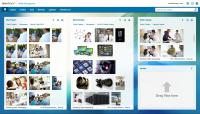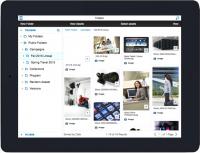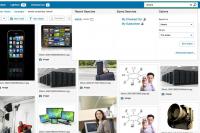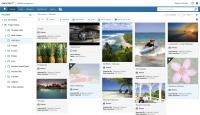Vendor Details
Contact Name
John PriceCompany Profile
OpenText is a global, publicly traded Canadian software company with more than 8200 employees in 140 offices around the world. Our software and technology help large and small enterprises manage and secure their unstructured digital data and rich media. Our broad portfolio of solutions, including DAM, is deployed both on premises and in the cloud.
OpenText began in the late '80s as a University of Waterloo research project to digitize all 60 million words of the Oxford Dictionary, and make them searchable (thus, the meaning behind "OpenText"). During that process the Internet's first search engine technology was created. OpenText incorporated in 1991 and the new search engine technology it invented was soon adopted by Yahoo!, one of its first customers. In 2004, OpenText acquired Artesia one of the original pioneers in Digital Asset Management.
If you look closely, every organization is a media company, with images, videos, marketing collateral, training materials, presentations, etc., all used to communicate inside and outside the firewall. OpenText shows you how to simplify, transform and accelerate your rich media throughout your enterprise.
OpenText Media Management has more than 20 years experience in DAM. We help you manage all your video, images, and rich media for the entire enterprise in one place. Media Management features a completely redesigned user experience that puts the digital content you want at your fingertips. Whether your typing or swiping, our simple yet powerful user interface makes your job easier. In Media Management the HTML5 interface and responsive design reduces complexity and unnecessary clutter to find what you need, share, collaborate, and use your digital assets.
Digital Asset Management is a core technology and a critical infrastructure component for the digital supply chain. From creation to consumption, OpenText Media Management provides a "single source of truth" and consolidated asset repository for marketing, branding, commerce, video and global distribution. It's an integral part of an ecosystem with interconnected and interdependent contributors and production environments (such as agencies, photo, video,audio, graphics, layout) provisioning digital media content for the omni-channel / cross-channel digital supply chain, digital operations, marketing and brand management. Whether your business focus is consumers in B2C; a B2B partner network, or a combination of suppliers, distributors and customers, in today’s multichannel world it's all about getting the right content and rich experiences to users on the platforms and devices they choose.
Media Management has engineered a platform allowing customers to respond to ever-growing demands for media rich content. By connecting people, processes, and content with APIs and other tools, plus a sophisticated yet simple HTML5 UI, Media Management supports enterprise-wide ecosystems. What this means for our customers is faster integrations with enterprise applications - such as web content management, ecommerce, customer communication, CRM, MRM, PIM / PCM - and easier customizations for the way your users expect to work.
As a leading enterprise Digital Asset Management solution, Media Management has workflow-driven, multichannel capabilities for producing, publishing, and distributing digital media and content through a secure, scalable platform. OpenText provides the core enterprise infrastructure, key platform components and capabilities supporting the DAM ecosystem with the efficiencies of "create-once, use-many" to repurpose, re-express, reuse, and re-create your rich media assets.
Our customers have measurable gains in cost savings and increased productivity from automated, collaborative processes and a centralized, searchable repository. Focusing on our core competency in DAM and a scalable platform to interconnect and integrate with other components in complex enterprise ecosystems is a major OpenText differentiator.
Screenshot

Contact Telephone
800-499-6544Contact Email
jprice@opentext.comCompany Website
http://www.opentext.comYears Trading
20+Company Turnover
This is the actual turnover of the vendor in US Dollars.
$1.5 billionOffice Locations
- OpenText Global Headquarters 275 Frank Tompa Drive Waterloo, ON N2L 0A1 Canada
- OpenText Office Locations http://www.opentext.com/who-we-are/office-locations
Product Name
OpenText Media ManagementLatest Version Number
v10.5 SP4Date Of Last Release
20/01/2015Documentation URL
https://knowledge.opentext.com/knowledge/cs.dll/Open/OTMM10_5User group URL
http://www.opentext.com/communityCompany RSS Feed URL
http://www.opentext.com/communityCompany LinkedIn URL
http://www.linkedin.com/company/opentextCompany Facebook URL
https://www.facebook.com/opentextPartner Network
If the vendor operates through a sales channel they may use intermediaries who have regional focus or additional specialisms in a given vertical market.
Licensing
Licensing Model
This refers to the type of licence the DAM system software is supplied under. Proprietary means that the developer restricts access to the source code (the instructions used to generate the software). Open source means that the developer provides full access to the code so you can modify it yourself. Split model is hybrid and means they may offer both options with some restrictions removed (or added) depending on the model chosen. If split is selected, it is advisable to verify the differences with the vendor.
Use of Open Source Components
Many DAM systems use freely available open source components to deliver key functionality. The products themselves may not be open source, however. This question will help to identify to what extent they are open source.
- Some open source components used, but core product is not open source
Hosting
Software Delivery Methods
- Installed (On-Premise)
- Hybrid
Technology
Client
Client refers to the type of hardware or software device that can be used to access or control the DAM system.
Client Notes
Screenshot

Server Operating Systems supported
This only applies for installed or hybrid DAM systems and refers to what types of OS they can be run on. This question is less relevant for DAM systems where a third party will be hosting it for you.
Web Server
The type of web server software that the DAM system can operate with. Not all DAM systems use a web server and for pure SaaS products the question is irrelevant. If you either want SaaS or non-web DAM systems, do not choose an option.
Software Development Technologies Used
This means the programming language or development technology used to implement the DAM system. This question is more important for open source software or if you have IT policy restrictions that require you to use (or not use) some technologies. It may not be relevant if you require a hosted DAM and never intend to host the system in-house.
Database Technology
The Database that the DAM system uses. All DAM systems require some kind of storage for asset metadata and they are usually based on an existing technology - but that may not always be a conventional database. If the DAM will be hosted by someone else (e.g. SaaS/Cloud) this question may not be relevant.
Search Technologies
This refers to third party search components that the vendor uses to provide the text search features (and sometimes other related search functions).
Search Technologies Notes
Screenshot

Service Oriented Architecture
Service Oriented Architecture (SOA) means the vendor's product uses a modular architecture where each core DAM function is delivered as a service which can be separated out independently from other functions. It is important for large-scale Digital Asset Management implementations or more complex integration requirements.
Unique SOA Services
If the vendor uses a Service Oriented Architecture, they should be able to identify a number of unique services that are isolated from each other. Note there is overlap between with question and the one about scalable asset processing. Some vendors do not have an SOA but do offer large scale asset processing capabilities.
- Metadata
- Storage
- Asset Media Processing
- User Authentication
- Workflow
Service Oriented Architecture Notes
Services and functionality is exposed via a comprehensive set of RESTful APIs
Search
Search Features
This describes the search strategies that can be used to find assets. If you do not understand any of them, leave the options de-selected. Most DAM systems should support at least keyword search at a minimum.
- Keyword
- Folders
- Filters
- Faceted Search
- Linked Asset Search
Search Notes
Screenshot

Index/Search Text Content Of Documents
Some DAM systems can search the text content of document assets and that might be important for your DAM solution.
Document Text Indexing Notes
Screenshot

Metadata
Embedded metadata support (reading)
Embedded metadata refers to information stored within asset files which can be searched from the DAM system. There are different standards for this type of metadata. Some image cataloguing software like Adobe Lightroom will write this data to asset files and a device like a camera may capture details also such as GPRS coordinates where an photo was shot. XMP metadata is often used with other types of files such as InDesign or PDF. If you are unsure whether this applied to you, do not check any options.
Embedded metadata support (writing)
See the reading question above for more details on what embedded metadata is. This question refers to whether embedded metadata can be written back to files if edited within the DAM system.
Controlled Vocabularies
Controlled Vocabularies are predefined lists of search terms. They can be realised in many different ways but the common factor is the user picks from a restricted selection rather than enters a keyword. Most DAM systems will usually support both controlled vocabularies and keywords.
User Defined Metadata Fields
The ability to configure metadata your own metadata fields is important for DAM systems so you can assign a dedicated field for certain items of information rather than using a generic classification method or one of the vendor's own standard fields.
- Yes
Screenshot

Cataloguing Interface Options
When cataloguing assets with custom fields, some metadata will be controlled selections, others will be free text. There are further choices like date fields, file attachments etc.
- Text field
- Text area (narrative)
- Date
- File attachment
Business Intelligence & Reporting
Asset Usage Records
To enable reports to be generated, DAM solutions must retain records of asset usage, including searching, download and editing of records. The reporting should include the user who carried out the activity and the date/time it occurred.
Audit Trail
A detailed audit trail that logs every user action in a central record is useful to gain insight into user behaviour. Comprehensive audit trails allow DAM system users to produce reports that address their unique needs.
Built-In Reports
A range of built-in reports that you can quickly generate is useful to answer common questions such as the "what is our most popular asset?".
- Most popular assets by download
- Most active users by uploads
- Most active users by downloads
- Average number of search results returned over a given period
- Asset search to download ratio
- Download activity over a given period
- Login activity over a given period
- Popular search terms
Asset Processing
Dedicated/Scalable Proxy or Derivative Asset Generation
Nearly all DAM systems will generate thumbnails and previews of media, including more dynamic types like video or audio. Some products use a separate server to do this which usually makes them more suitable for large scale asset ingestion and processing.
Dedicated/Scalable Proxy or Derivative Asset Generation Notes
If needed for scalability
Multi-Page Document Asset Previews
If you deal with document oriented assets, having a solution which can generate multi-page previews (and also zoom in on them) can save the hassle of downloading a file only to discover it is not the one you need. For assets with very similar content, this can be a useful feature.
Asset Manipulation
Image Manipulation
Many DAM systems allow users to manipulate images by resizing, cropping etc. Choose any features which are important to your users.
- Image re-sizing
- Format conversion
Video Manipulation
Some DAM systems may allow video assets to be converted or modified. If that is a potential requirement for you, specify those features which are likely to be needed. EDL = Edit Decision List and refers to providing in/out points when editing video footage.
- Format conversion
- EDLs and editing features
- Timeline metadata
- Batch operations on multiple video assets
Video Manipulation Notes
Storyboard view in asset details. Create new child asset from parent, mark in out and generate new asset.
Integration
API
API means Application Programming Interface and allows third party software to control a DAM system. If you intend to integrate your DAM with another existing solution then you need to choose the API protocol that is compatible with that.
Storage Integration
Many DAM solutions will now allow assets to be stored on the server of Cloud storage providers. This allows asset files to be distributed and/or integrated with other solutions. Some third party services use generic protocols like FTP, others are proprietary.
- Amazon S3
- Amazon Glacier
- FTP
- Microsoft Azure Blob
Storage Integration Notes
OpenText Cloud Storage.
Scripting & Plug-Ins
Scripting Capabilities
Some advanced DAM solutions have a scripting capability that allows users or third parties to add functionality which the vendor did not originally envisage. Usually programming skills will be required to use this, but some tools have visual interfaces also.
Plug-In Support
In addition to scripting (or sometimes instead of), some DAM solutions will have a plug-in architecture that allows third party developers to extend the core platform.
Authentication
Authentication Support
If you need to integrate with an existing corporate authentication service then this option will be important for you.
Multi-Lingual Options
Multilingual Application Interface Support
The interface means the controls to use the DAM system. This is different from the metadata support which is usually entered by end users when cataloguing assets.
- English
- Chinese (Mandarin)
- French
- Spanish
- Italian
- German
Multilingual Metadata Support
See previous question. Most DAM systems with multi-lingual support will provide it for metadata.
Multilingual Support Notes
Portuguese
Japanese
Version Control
File versioning
File versioning refers to the digital media associated with an asset record. This is usually the minimum requirement for a DAM system to claim support for versioning assets. See also responses to the related question about metadata versioning below.
Metadata versioning
Metadata versioning is separate from the files associated with assets. Many DAM solutions will track updated digital assets but only retain a single current version of the metadata. Since metadata is likely to be edited many more times than assets get replaced, this can be an important point to check.
Independent Metadata And File Versioning
This questions assesses whether the solution allows versions of either the file or metadata to be reverted independently or if both are linked to a single shared version instance.







